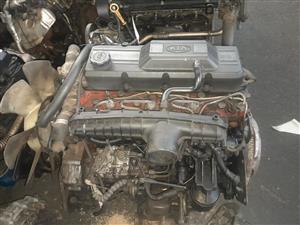Enhance Your Trip with a High-Quality Opel Corsa Engine
Enhance Your Trip with a High-Quality Opel Corsa Engine
Blog Article
Checking Out the Inner Functions of a Compact Vehicle's Engine System
As drivers, we usually take for given the detailed processes that happen within the boundaries of our car's engine system. In this expedition of a compact automobile's engine system, we will decipher the internal workings of this mechanical symphony, dropping light on the enigmas that drive us forward on our everyday trips.
Combustion Process Review
The combustion process in a small lorry's engine system is a vital device that successfully converts fuel right into power to power the vehicle. This process happens within the burning chamber of the engine, where gas and air mix, ignite, and create regulated explosions. The combustion process includes 4 primary phases: intake, power, exhaust, and compression.
During the consumption phase, the piston moves downward, attracting in a blend of air and fuel right into the combustion chamber. The following stage, compression, includes the piston moving up, compressing the air-fuel blend to enhance its effectiveness. Consequently, in the power phase, the ignition system ignites the pressed mixture, leading to a rapid growth of gases that compels the piston back down. This descending movement produces the power required to drive the car. Ultimately, in the exhaust stage, the burnt gases are eliminated from the combustion chamber with the exhaust shutoff, preparing the chamber for the next cycle. This cyclic burning procedure is fundamental to the operation of a small lorry's engine system, making sure reliable energy conversion for propulsion.
Piston and Cyndrical Tube Communication

The piston's accurate fit within the cylinder is vital for maintaining optimal compression and preventing power loss throughout burning. Limited clearances between the piston and cylinder walls ensure reliable securing, permitting the piston to relocate smoothly without permitting gases to leakage past. Correct lubrication is also important to reduce friction and put on in between these components, improving longevity and performance.
Moreover, the design and materials used in manufacturing the piston and cylinder influence engine performance and durability. Modern engines often use light-weight yet long lasting materials like light weight aluminum alloys for pistons and cyndrical tube liners to lower inertia and enhance thermal efficiency. On the whole, the harmonious interaction in between the piston and cylinder is fundamental to the engine's capability and general performance.
Gas Injection System Functionality
Gas injection systems in portable car engines play a crucial role in specifically delivering gas to the combustion chamber for reliable and controlled ignition. The gas shot system functions by infusing fuel right into the burning chamber at the ideal minute during the engine's procedure (opel corsa engine). This accurate timing ensures that the fuel blends uniformly with the air for correct combustion, bring about enhanced gas efficiency and decreased emissions
There are largely two kinds of fuel shot systems used in small vehicle engines: port fuel injection (PFI) her explanation and straight fuel shot (DFI) PFI systems inject fuel right into the intake port before the consumption shutoff, while DFI systems inject gas straight into the combustion chamber. Both systems have their benefits, with DFI offering much better gas atomization and PFI providing a more economical solution.
Comprehending Engine Air Conditioning Devices
Efficient procedure of a small car's engine relies heavily on the performance of its cooling devices. The air conditioning system in a you could try here small vehicle generally is composed of a number of elements functioning together to manage the engine temperature level. Comprehending these engine cooling devices is crucial for preserving the efficiency and durability of a compact lorry's engine system.

Exhaust System Components Explained
The optimal performance of a portable lorry's engine cooling mechanisms relies on a complementary system known as the exhaust system, which makes up different important components for making certain reliable exhausts and engine efficiency. The exhaust system consists of components such as the exhaust manifold, catalytic converter, muffler, and tailpipe. The exhaust manifold accumulates exhaust gases from the engine's paths and cylinders them to the catalytic converter. The catalytic converter after that converts dangerous toxins in the exhaust into much less hazardous exhausts before launching them through the muffler and tailpipe.
One crucial element of the exhaust system is the oxygen sensor, which checks the oxygen degrees in the exhaust gases to More about the author help control gas consumption and make sure optimum engine efficiency. opel corsa engine. Additionally, the resonator might exist in some exhaust systems to minimize sound degrees. Overall, the exhaust system plays a crucial duty in keeping engine effectiveness, lowering hazardous discharges, and making sure a quieter driving experience for portable vehicle owners

Verdict
In conclusion, the compact lorry's engine system is a complex mix of components that interact to facilitate the combustion process, convert fuel right into power, and eliminate waste gases. Understanding the inner functions of the engine system, including the piston and cylinder communication, gas shot system, engine cooling systems, and exhaust system elements, is critical for keeping optimal performance and efficiency of the vehicle.
The combustion process in a compact car's engine system is a vital system that effectively transforms fuel into energy to power the car.Fuel injection systems in compact vehicle engines play a critical role in specifically supplying gas to the burning chamber for effective and controlled ignition.There are primarily 2 kinds of gas injection systems used in compact vehicle engines: port gas shot (PFI) and direct fuel shot (DFI) Recognizing these engine air conditioning systems is important for maintaining the efficiency and long life of a small car's engine system.
The ideal functioning of a compact vehicle's engine cooling devices depends on a corresponding system understood as the exhaust system, which comprises numerous crucial parts for making sure effective emissions and engine performance.
Report this page